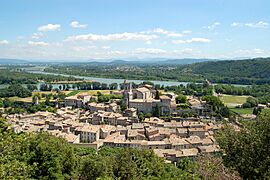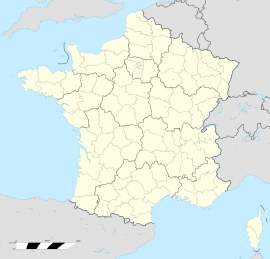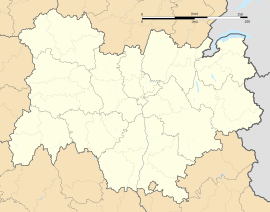Viviers, Ardèche facts for kids
Quick facts for kids
Viviers
|
||
|---|---|---|
 |
||
|
||
| Country | France | |
| Region | Auvergne-Rhône-Alpes | |
| Department | Ardèche | |
| Arrondissement | Privas | |
| Canton | Bourg-Saint-Andéol | |
| Intercommunality | Rhône aux Gorges de l'Ardèche | |
| Area
1
|
34.15 km2 (13.19 sq mi) | |
| Population
(2021)
|
3,674 | |
| • Density | 107.584/km2 (278.64/sq mi) | |
| Time zone | UTC+01:00 (CET) | |
| • Summer (DST) | UTC+02:00 (CEST) | |
| INSEE/Postal code |
07346 /07220
|
|
| Elevation | 55–400 m (180–1,312 ft) (avg. 71 m or 233 ft) |
|
| 1 French Land Register data, which excludes lakes, ponds, glaciers > 1 km2 (0.386 sq mi or 247 acres) and river estuaries. | ||
Viviers is a charming village located in the Ardèche area of southern France. It is also sometimes called Viviers-sur-Rhône because it sits right by the Rhône river. This historic village is famous for its old cathedral and the beautiful views it offers over the river. As of 2021, about 3,674 people live there.
Contents
A Look at Viviers' Past
How Viviers Got Its Name
The name Viviers comes from the Latin word Vivarium. This word referred to special ponds built by the ancient Romans. These ponds were used for raising fish right on the banks of the Rhône river. The fish were then sent to feed the people in a nearby Roman town called Alba Helviorum. You can still see a Roman-built bridge near the village center today. It was built to help with trade in the area.
From Ancient Tribes to Kingdoms
Viviers became an important place after the nearby town of Alba-la-Romaine started to decline. It became the main city for a Gaulish tribe called the Helvii. Later, in the 5th century, Viviers became part of the Kingdom of the Burgundians. After that, it was taken over by the Franks, another powerful group.
Becoming a Religious Center
In the late 5th century, Viviers became a very strong episcopal seat. This means it was the main center for a bishop, who is a high-ranking church leader. It also became the capital of the pays Vivarais, which was the surrounding region. Even today, Viviers is still the home of the Bishop of Viviers. A famous bishop named Venant de Viviers served here in the 6th century.
Changes in Power
In the 9th century, Viviers and the Vivarais region became part of the Kingdom of Provence. Eventually, from 933 to 1032, it was a key part of the Kingdom of Arles. The city was then part of the Holy Roman Empire from 1032 until 1307.
After a few years of changes, from 1305 to 1308, the area finally joined the Kingdom of France. It was then made into a county. From the 15th century onwards, the bishops of Viviers held important titles. They were called the Count of Viviers and the Prince of Donzère and Châteauneuf-du-Rhône.
Wars and Rebuilding
After joining France, Viviers made its city walls stronger. This helped protect it during the Hundred Years' War, a long conflict. In the early 16th century, Claude of Tournon became bishop. He was a chaplain to Anne of Brittany, a powerful queen. He invested a lot of money and effort into improving the town.
However, later in the same century, a citizen named Noel Albert took control of the town for the Protestants. This brought Viviers into the French Wars of Religion, and the Cathedral was badly damaged. After Albert was executed and the wars ended, Viviers became less important. The bishops, who had left the city during the fighting, only came back in the 18th century. They returned after a large new Bishop's Palace was built.
Modern Viviers
Viviers managed to avoid major damage during the French Revolution. This was because its Bishop, Charles de La Font de Savine, supported the new revolutionary government. In 1858, Joseph-Hippolyte Guibert gave three beautiful Gobelins tapestries to the Cathedral. These tapestries are still there today.
The 19th century brought new factories and a small increase in people living in Viviers. Today, the town is a popular place for tourists. People come to see its many historic buildings. These include the medieval Cathedral of St. Vincent and the Grande Rue, a street with many lovely 18th-century houses.
See also
 In Spanish: Viviers (Ardèche) para niños
In Spanish: Viviers (Ardèche) para niños




